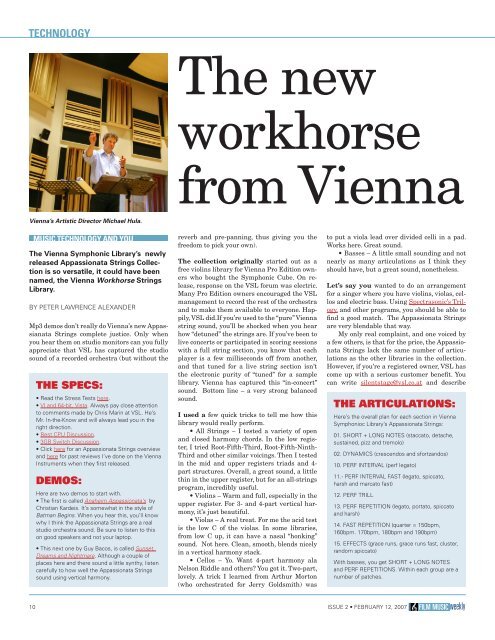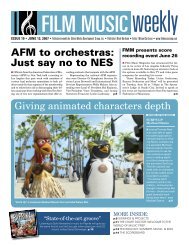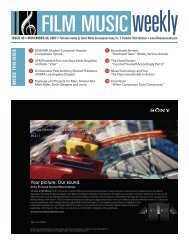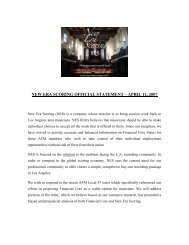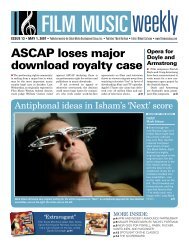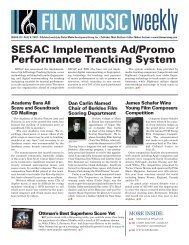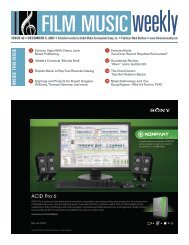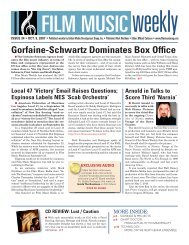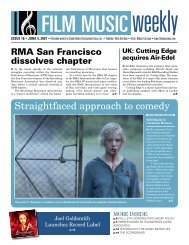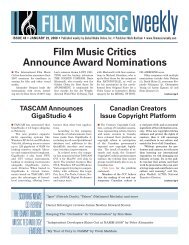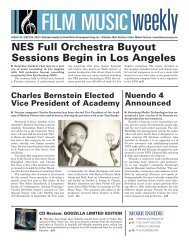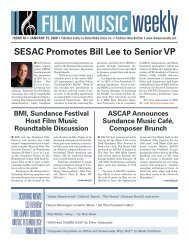February 12, 2007 - Film Music Magazine
February 12, 2007 - Film Music Magazine
February 12, 2007 - Film Music Magazine
Create successful ePaper yourself
Turn your PDF publications into a flip-book with our unique Google optimized e-Paper software.
TECHNOLOGY<br />
Vienna’s Artistic Director Michael Hula.<br />
MUSIC TECHNOLOGY AND YOU<br />
The Vienna Symphonic Library’s newly<br />
released Appassionata Strings Collection<br />
is so versatile, it could have been<br />
named, the Vienna Workhorse Strings<br />
Library.<br />
BY PETER LAWRENCE ALEXANDER<br />
Mp3 demos don’t really do Vienna’s new Appassianata<br />
Strings complete justice. Only when<br />
you hear them on studio monitors can you fully<br />
appreciate that VSL has captured the studio<br />
sound of a recorded orchestra (but without the<br />
THE SPECS:<br />
• Read the Stress Tests here.<br />
• VI and 64-bit, Vista. Always pay close attention<br />
to comments made by Chris Marin at VSL. He’s<br />
Mr. In-the-Know and will always lead you in the<br />
right direction.<br />
• Best CPU Discussion.<br />
• 3GB Switch Discussion.<br />
• Click here for an Appassionata Strings overview<br />
and here for past reviews I’ve done on the Vienna<br />
Instruments when they first released.<br />
DEMOS:<br />
Here are two demos to start with.<br />
• The first is called Anaheim Appassionata’s by<br />
Christian Kardeis. It’s somewhat in the style of<br />
Batman Begins. When you hear this, you’ll know<br />
why I think the Appassionata Strings are a real<br />
studio orchestra sound. Be sure to listen to this<br />
on good speakers and not your laptop.<br />
• This next one by Guy Bacos, is called Sunset,<br />
Dreams and Nightmare. Although a couple of<br />
places here and there sound a little synthy, listen<br />
carefully to how well the Appassionata Strings<br />
sound using vertical harmony.<br />
The new<br />
workhorse<br />
from Vienna<br />
reverb and pre-panning, thus giving you the<br />
freedom to pick your own).<br />
The collection originally started out as a<br />
free violins library for Vienna Pro Edition owners<br />
who bought the Symphonic Cube. On release,<br />
response on the VSL forum was electric.<br />
Many Pro Edition owners encouraged the VSL<br />
management to record the rest of the orchestra<br />
and to make them available to everyone. Happily,<br />
VSL did.If you’re used to the “pure” Vienna<br />
string sound, you’ll be shocked when you hear<br />
how “detuned” the strings are. If you’ve been to<br />
live concerts or participated in scoring sessions<br />
with a full string section, you know that each<br />
player is a few milliseconds off from another,<br />
and that tuned for a live string section isn’t<br />
the electronic purity of “tuned” for a sample<br />
library. Vienna has captured this “in-concert”<br />
sound. Bottom line – a very strong balanced<br />
sound.<br />
I used a few quick tricks to tell me how this<br />
library would really perform.<br />
• All Strings – I tested a variety of open<br />
and closed harmony chords. In the low register,<br />
I tried Root-Fifth-Third, Root-Fifth-Ninth-<br />
Third and other similar voicings. Then I tested<br />
in the mid and upper registers triads and 4part<br />
structures. Overall, a great sound, a little<br />
thin in the upper register, but for an all-strings<br />
program, incredibly useful.<br />
• Violins – Warm and full, especially in the<br />
upper register. For 3- and 4-part vertical harmony,<br />
it’s just beautiful.<br />
• Violas – A real treat. For me the acid test<br />
is the low C of the violas. In some libraries,<br />
from low C up, it can have a nasal “honking”<br />
sound. Not here. Clean, smooth, blends nicely<br />
in a vertical harmony stack.<br />
• Cellos – Yo. Want 4-part harmony ala<br />
Nelson Riddle and others? You got it. Two-part,<br />
lovely. A trick I learned from Arthur Morton<br />
(who orchestrated for Jerry Goldsmith) was<br />
to put a viola lead over divided celli in a pad.<br />
Works here. Great sound.<br />
• Basses – A little small sounding and not<br />
nearly as many articulations as I think they<br />
should have, but a great sound, nonetheless.<br />
Let’s say you wanted to do an arrangement<br />
for a singer where you have violins, violas, cellos<br />
and electric bass. Using Spectrasonic’s Trilogy,<br />
and other programs, you should be able to<br />
find a good match. The Appassionata Strings<br />
are very blendable that way.<br />
My only real complaint, and one voiced by<br />
a few others, is that for the price, the Appassionata<br />
Strings lack the same number of articulations<br />
as the other libraries in the collection.<br />
However, if you’re a registered owner, VSL has<br />
come up with a serious customer benefit. You<br />
can write silentstage@vsl.co.at and describe<br />
THE ARTICULATIONS:<br />
Here’s the overall plan for each section in Vienna<br />
Symphonioc Library’s Appassionata Strings:<br />
01. SHORT + LONG NOTES (staccato, detache,<br />
sustained, pizz and tremolo)<br />
02. DYNAMICS (crescendos and sfortzandos)<br />
10. PERF INTERVAL (perf legato)<br />
11.- PERF INTERVAL FAST (legato, spiccato,<br />
harsh and marcato fast)<br />
<strong>12</strong>. PERF TRILL<br />
13. PERF REPETITION (legato, portato, spiccato<br />
and harsh)<br />
14. FAST REPETITION (quarter = 150bpm,<br />
160bpm. 170bpm, 180bpm and 190bpm)<br />
15. EFFECTS (grace runs, grace runs fast, cluster,<br />
random spiccato)<br />
With basses, you get SHORT + LONG NOTES<br />
and PERF REPETITIONS. Within each group are a<br />
number of patches.<br />
10 ISSUE 2 • FEBRUARY <strong>12</strong>, <strong>2007</strong> FILM MUSIC weekly


